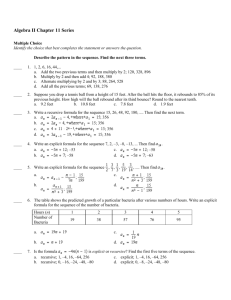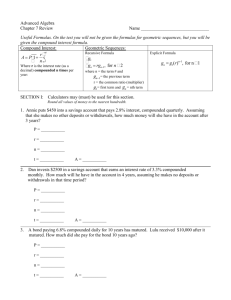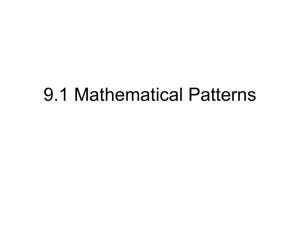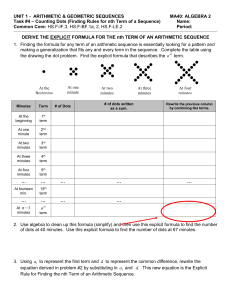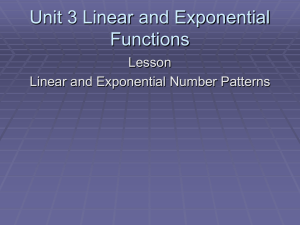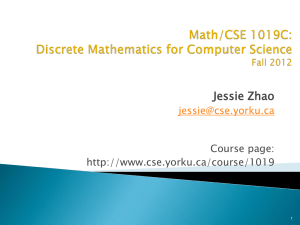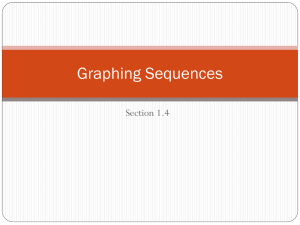Lesson 1: Recursive and Explicit Formulas
advertisement
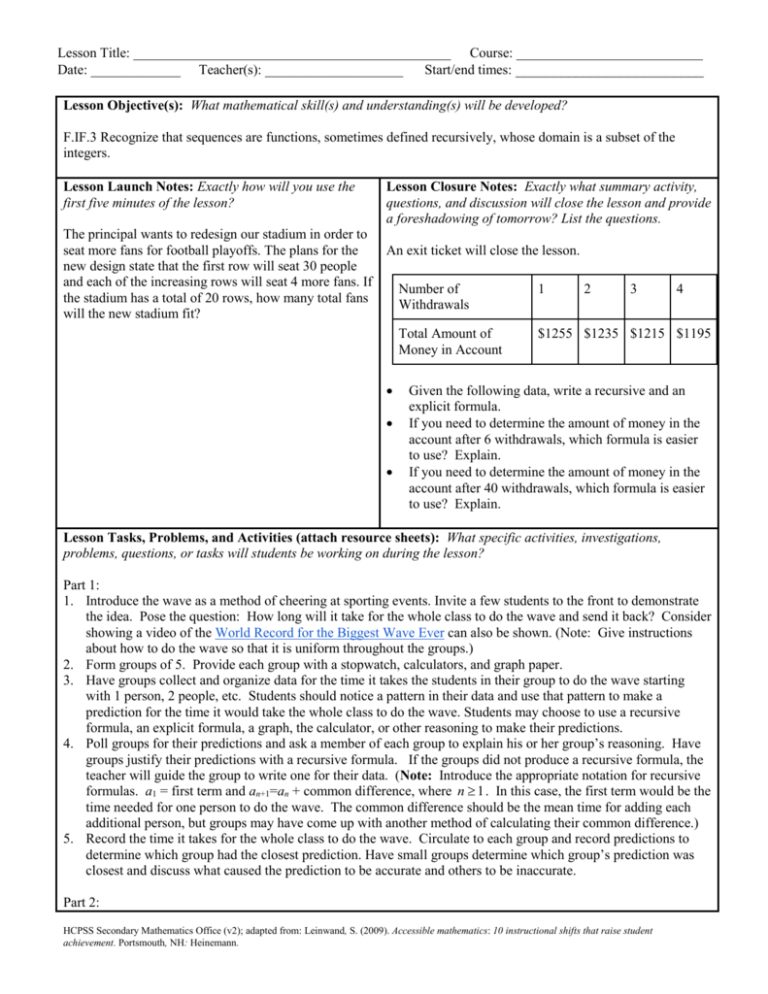
Lesson Title: ______________________________________________ Course: ___________________________ Date: _____________ Teacher(s): ____________________ Start/end times: _________________________ Lesson Objective(s): What mathematical skill(s) and understanding(s) will be developed? F.IF.3 Recognize that sequences are functions, sometimes defined recursively, whose domain is a subset of the integers. Lesson Launch Notes: Exactly how will you use the first five minutes of the lesson? The principal wants to redesign our stadium in order to seat more fans for football playoffs. The plans for the new design state that the first row will seat 30 people and each of the increasing rows will seat 4 more fans. If the stadium has a total of 20 rows, how many total fans will the new stadium fit? Lesson Closure Notes: Exactly what summary activity, questions, and discussion will close the lesson and provide a foreshadowing of tomorrow? List the questions. An exit ticket will close the lesson. Number of Withdrawals 1 2 3 4 Total Amount of Money in Account $1255 $1235 $1215 $1195 Given the following data, write a recursive and an explicit formula. If you need to determine the amount of money in the account after 6 withdrawals, which formula is easier to use? Explain. If you need to determine the amount of money in the account after 40 withdrawals, which formula is easier to use? Explain. Lesson Tasks, Problems, and Activities (attach resource sheets): What specific activities, investigations, problems, questions, or tasks will students be working on during the lesson? Part 1: 1. Introduce the wave as a method of cheering at sporting events. Invite a few students to the front to demonstrate the idea. Pose the question: How long will it take for the whole class to do the wave and send it back? Consider showing a video of the World Record for the Biggest Wave Ever can also be shown. (Note: Give instructions about how to do the wave so that it is uniform throughout the groups.) 2. Form groups of 5. Provide each group with a stopwatch, calculators, and graph paper. 3. Have groups collect and organize data for the time it takes the students in their group to do the wave starting with 1 person, 2 people, etc. Students should notice a pattern in their data and use that pattern to make a prediction for the time it would take the whole class to do the wave. Students may choose to use a recursive formula, an explicit formula, a graph, the calculator, or other reasoning to make their predictions. 4. Poll groups for their predictions and ask a member of each group to explain his or her group’s reasoning. Have groups justify their predictions with a recursive formula. If the groups did not produce a recursive formula, the teacher will guide the group to write one for their data. (Note: Introduce the appropriate notation for recursive formulas. a1 = first term and an+1=an + common difference, where n 1 . In this case, the first term would be the time needed for one person to do the wave. The common difference should be the mean time for adding each additional person, but groups may have come up with another method of calculating their common difference.) 5. Record the time it takes for the whole class to do the wave. Circulate to each group and record predictions to determine which group had the closest prediction. Have small groups determine which group’s prediction was closest and discuss what caused the prediction to be accurate and others to be inaccurate. Part 2: HCPSS Secondary Mathematics Office (v2); adapted from: Leinwand, S. (2009). Accessible mathematics: 10 instructional shifts that raise student achievement. Portsmouth, NH: Heinemann. Lesson Title: ______________________________________________ Course: ___________________________ Date: _____________ Teacher(s): ____________________ Start/end times: _________________________ 1. Focusing on the data of the closest group, pose the following question, “If the whole school, 1,400 students, is doing the wave, how long will it take?” Monitor groups’ progress while asking guiding questions to lead students to an explicit formula. Students may choose to graph by hand, graph on the calculator, or find patterns from the data table. Students should also define variables based on the problem. 2. Bring the class together to introduce the vocabulary of explicit and recursive formulas. Compare and discuss the connection between the two formulas. (Note: The common difference in the recursive formula is the slope in the explicit formula.) Ask students about the real-world meaning of the y-intercept. (NOTE: The y-intercept in the case of the wave is related to the time it takes the timer to start and stop the stopwatch. Evidence of Success: What exactly do I expect students to be able to do by the end of the lesson, and how will I measure student mastery? That is, deliberate consideration of what performances will convince you (and any outside observer) that your students have developed a deepened (and conceptual) understanding. Students should be able to write an explicit and recursive formula given an arithmetic data set or sequence. They should be able to recognize the limitation of the recursive formula and the connections between the two formulas. The next lesson will address the explicit and recursive formulas for a geometric data set. Notes and Nuances: Vocabulary, connections, common mistakes, typical misconceptions, etc. Sequences can be defined either explicitly or recursively. An explicit formula allows the user to find a sequence term by simply substituting the term-number into the formula and evaluating. A recursive formula relates each term of a sequence to the term before. In order to find a sequence term, the user must find all prior terms in chronological order. The common difference in the recursive formula is the slope in the explicit formula. Review that the y-intercept is f(0) or the zero term. In the case of the wave, the y-intercept represents the time it takes for the timer to start and stop the stopwatch. Students could have the option to work independently to find the explicit formula. Another option to supplement or complement the wave is the Telephone game where students determine the amount of time for a message to reach 2 people, 3 people, etc. Resources: What materials or resources are essential for students to successfully complete the lesson tasks or activities? Homework: Exactly what follow-up homework tasks, problems, and/or exercises will be assigned upon the completion of the lesson? Stopwatches Graph paper Graphing Calculator Find or generate a real-life data set that has a constant common difference and include at least 5 data points. Write the explicit and recursive formulas for the data sets. (This will be used in the opening of the Recursive/Explicit Geometric lesson.) Lesson Reflections: What questions, connected to the lesson objectives and evidence of success, will you use to reflect on the effectiveness of this lesson? Can students distinguish between explicit and recursive formulas? Can students write explicit and recursive formulas given an arithmetic data set? Can students determine and justify the appropriate formula to be used for different input values? HCPSS Secondary Mathematics Office (v2); adapted from: Leinwand, S. (2009). Accessible mathematics: 10 instructional shifts that raise student achievement. Portsmouth, NH: Heinemann.


